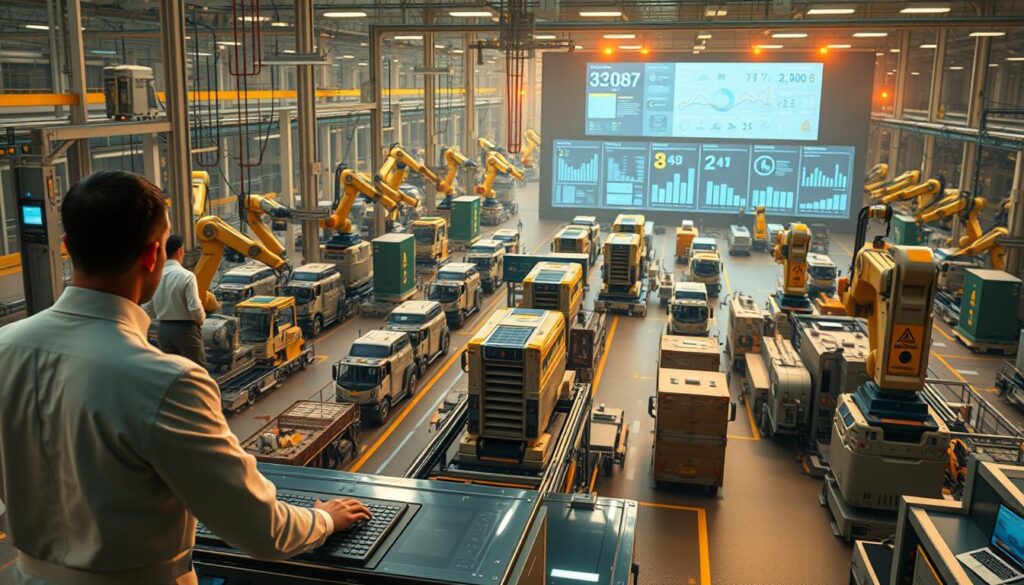“Artificial intelligence is the future, and the future is here.” – Bill Gates. This quote underscores the pivotal role AI plays in reshaping industries and economies worldwide. Among the nations leading this charge, one stands out for its rapid advancements and strategic investments in this transformative field.
With over 4,300 companies contributing to its AI industry, China has become a global powerhouse in artificial intelligence. The country’s AI sector is projected to expand to over $140 billion by 2030, with related sectors expected to reach a staggering $1.4 trillion1. This growth is fueled by significant investments, including $184 billion in government venture capital funds between 2000 and 20232.
China’s focus on AI extends beyond financial commitments. The nation is also driving innovation through technical breakthroughs and robust research. For instance, Alibaba’s Qwen 1.5 model, with 72 billion parameters, showcases the country’s capabilities in the open-source LLM ecosystem2. These advancements are narrowing the gap between Chinese and U.S. AI models, as seen in recent benchmark comparisons2.
Key Takeaways
- China’s AI industry is set to exceed $140 billion by 2030, with related sectors reaching $1.4 trillion1.
- Government venture capital funds have invested $184 billion in AI firms since 20002.
- Technical breakthroughs, like Alibaba’s Qwen 1.5 model, highlight China’s innovation in artificial intelligence2.
- The gap between Chinese and U.S. AI models is decreasing, reflecting improved performance2.
- Over 4,300 companies are driving China’s AI industry forward1.
Introduction: The Rise of AI in China

The artificial intelligence landscape is rapidly evolving, with China at the forefront of this transformation. Over the past decade, the country has emerged as a global leader in AI innovation, driven by strategic investments and cutting-edge technologies. This section explores how government initiatives and company advancements are shaping the new era of artificial intelligence.
Defining the New Era of Artificial Intelligence
China’s AI industry has grown exponentially, with over 4,500 companies contributing to its development by the first quarter of 2024, representing 15% of the global total3. This growth is fueled by a combination of government support and private sector innovation. For instance, the added value of the core AI industry reached RMB 508 billion (US$75 billion) in 2022, marking an 18% year-on-year increase3.
The government has played a pivotal role in this progress. Through policies and subsidies, it has created an environment conducive to innovation. The Shanghai municipal government, for example, established a US$13.8 billion parent fund to support key sectors, including AI3. Such initiatives have enabled companies to develop advanced models and integrate them into everyday applications.
Leading Chinese firms are also making significant strides. Alibaba’s Qwen model, for instance, is used by 90,000 enterprises across various sectors, including healthcare and gaming4. This highlights the practical impact of these innovations. Additionally, the Cyberspace Administration of China has approved the release of more than 40 large language models in the past six months, showcasing the country’s commitment to advancing AI technologies4.
| Key Metrics | 2022 | 2023 | 2024 (Projected) |
|---|---|---|---|
| Number of AI Companies | 4,300 | 4,500 | 4,700 |
| Core AI Industry Value (US$ billion) | 75 | 85 | 100 |
| Government Funding (US$ billion) | 13.8 | 15 | 16.5 |
These developments position China as a formidable contender in the global AI race. The integration of state-of-the-art technologies into industries like manufacturing, healthcare, and finance underscores the transformative potential of AI. For more insights into the tools driving this revolution, explore the best AI tools in 2023.
In conclusion, China’s rapid advancements in artificial intelligence are a testament to its strategic vision and collaborative efforts between the government and private sector. As the country continues to innovate, its influence on the global AI landscape will only grow stronger.
China’s Strategic Investment in AI Research

The fusion of government and private funding is accelerating advancements in AI systems. This dual approach ensures that innovative research and practical applications are prioritized, driving the next wave of artificial intelligence development.
Government Funding and Subsidies
Government-directed capital plays a critical role in advancing AI research. Between 2000 and 2023, Chinese government venture capital funds invested $184 billion in over 9,623 unique firms through more than 20,000 transactions2. This funding supports domestic AI companies, enabling them to develop cutting-edge systems and applications.
Guidance funds and subsidies are key mechanisms. For example, the Shanghai municipal government established a $13.8 billion parent fund to bolster key sectors, including artificial intelligence5. Such initiatives create a supportive environment for innovation and growth.
Private Sector Contributions
Private venture capital is increasingly focused on AI-related systems. In 2023, the sum of VC investments in China reached approximately $20 billion2. This reflects growing confidence in the potential of AI technologies to transform industries.
Major funding rounds highlight this trend. For instance, five generative AI start-ups in China are now valued at over $1 billion, earning them the title of the “new AI Tigers of China”2. These investments are channeled into practical applications, from healthcare to finance.
| Investment Type | 2022 | 2023 | 2024 (Projected) |
|---|---|---|---|
| Government Funding (US$ billion) | 13.8 | 15 | 16.5 |
| Private VC Investments (US$ billion) | 18 | 20 | 22 |
Comparative data shows that while the U.S. leads in total AI investments, China is rapidly closing the gap. In 2023, the U.S. recorded $55 billion in VC investments, compared to China’s $20 billion2. This highlights the competitive nature of the global AI race.
These strategic investments are not just about funding. They are about creating a robust ecosystem where research and application go hand in hand. This approach ensures that artificial intelligence continues to evolve, benefiting industries and societies worldwide.
Building a Robust AI Ecosystem

The foundation of a thriving AI ecosystem lies in nurturing talent and fostering innovation. Across the country, educational institutions and corporations are working together to create a sustainable environment for growth. This collaboration ensures that the industry remains competitive on a global scale.
Talent Development and Training Initiatives
Leading universities like Tsinghua are at the forefront of this effort. They provide specialized training programs that prepare students for careers in artificial intelligence. These initiatives are designed to bridge the gap between academic research and real-world applications6.
Corporations are also playing a key role. Many companies have launched internal training programs to upskill their workforce. This focus on talent development ensures that the industry has the expertise needed to drive innovation forward7.
Collaboration between academia and industry is another critical factor. For example, Tsinghua University has partnered with tech giants to incubate startups. These partnerships create opportunities for students to apply their knowledge in practical settings6.
Such efforts are not just about training individuals. They are about building a culture of continuous learning and innovation. This approach ensures that the country remains a leader in the global AI landscape.
In conclusion, the focus on talent development and training is shaping the future of the industry. By investing in people and fostering collaboration, the country is building a robust ecosystem that drives innovation and growth.
Dominance in the AI Market and Global Impact

The global AI market is witnessing a seismic shift, driven by rapid advancements and strategic expansions. Reports indicate that companies are rapidly capturing market share worldwide, setting trends in both commercial and strategic domains8. This growth is reshaping industries and influencing global trade dynamics.
Market Trends and International Reach
Leadership in AI is being achieved through rapid development and deployment of innovative solutions. For instance, 82% of global AI venture capital funding went to the U.S. and China in 2020, with China securing $16.9 billion8. This financial backing has enabled the creation of advanced models that are now used globally.
International reach is another key factor. AI solutions are being exported to various regions, including Europe and Southeast Asia. This expansion is supported by multilingual processing capabilities, which give these technologies a competitive edge in international business communication9.
Comparative insights with American technologies reveal unique advantages. While the U.S. leads in total AI investments, the gap is narrowing. For example, China produced 957,840 AI papers, accounting for 17.70% of global output, compared to the U.S.’s 25.23%8. This highlights the competitive nature of the global AI race.
| Region | AI Papers (2020) | Venture Capital Funding (2020) |
|---|---|---|
| U.S. | 1,365,452 | $27.6 billion |
| China | 957,840 | $16.9 billion |
The ripple effects on global markets are significant. AI advancements are transforming industries like healthcare, finance, and manufacturing. For more insights into the tools driving this revolution, explore top AI tools.
Looking ahead, future market directions will likely focus on scalability and integration. Strategic investments in computing power and data strategies will play a crucial role in maintaining leadership9. These efforts ensure that AI continues to evolve, benefiting industries and societies worldwide.
10 Ways China is Revolutionizing AI Technology

Innovative start-ups are redefining the artificial intelligence landscape with bold strategies and cutting-edge solutions. These companies are not just competing globally but also setting new benchmarks for innovation and efficiency.
Prominent examples like Zhipu AI, Baichuan AI, Moonshot AI, and MiniMax showcase how these start-ups are pushing boundaries. Their approaches range from advanced natural language processing to generative models, demonstrating the diversity of their contributions10.
Strategic investment plays a crucial role in their success. For instance, Zhipu AI has secured significant funding, enabling it to develop models that rival global competitors. This financial backing allows these companies to take calculated risks and innovate rapidly11.
The global impact of these start-ups is undeniable. Their technologies are being adopted across industries, from healthcare to finance, reshaping how businesses operate. This influence extends beyond their home country, making them key players in the world of artificial intelligence10.
Case studies reveal their unique strategies. Moonshot AI, for example, focuses on multilingual processing, giving it an edge in international markets. Similarly, MiniMax has developed models that integrate seamlessly into enterprise systems, showcasing its versatility11.
These start-ups are not just innovating; they are also addressing challenges like data privacy and ethical concerns. By balancing innovation with responsibility, they are setting a precedent for the industry10.
In conclusion, the rise of these start-ups highlights the transformative power of artificial intelligence. Their bold approaches and strategic investments are driving the next wave of technological advancements, shaping the future of the world.
Advancements in AI Research Methodologies

Breakthroughs in artificial intelligence research are reshaping the global tech landscape, driven by innovative methodologies and cutting-edge algorithms. These advancements are not only pushing the boundaries of what’s possible but also addressing long-standing challenges in the sector.
Breakthrough AI Models and Algorithms
Recent developments in AI models and algorithms have set new benchmarks for performance. For instance, the SuperCLUE benchmark shows significant improvements in Chinese models, narrowing the gap with their U.S. counterparts12. These models leverage advanced training techniques and innovative designs to achieve higher accuracy and efficiency.
One key factor driving these breakthroughs is the focus on talent. Leading researchers and engineers are developing algorithms that can process vast amounts of data with unprecedented speed. This emphasis on human expertise ensures that the sector continues to evolve at a rapid pace8.
Data-Driven Innovation Strategies
Data-driven strategies are at the heart of modern AI research. By analyzing large datasets, researchers can identify patterns and optimize algorithms for better performance. This approach has been instrumental in overcoming traditional restrictions and enabling new applications in fields like healthcare and finance13.
For example, the integration of AI tools into business processes has transformed how companies operate. Tools like those highlighted in top AI tools are now essential for driving innovation and staying competitive. This shift underscores the importance of data in shaping the future of AI.
In conclusion, advancements in AI research methodologies are revolutionizing the tech landscape. By focusing on breakthrough models, algorithms, and data-driven strategies, the industry is overcoming challenges and setting new standards for innovation. The role of talent and the ability to navigate restrictions will continue to be critical in driving progress in this dynamic sector.
Role of Tsinghua University and Leading Academics

Tsinghua University has emerged as a cornerstone in the development of cutting-edge artificial intelligence technologies. Its contributions extend beyond academic research, playing a pivotal role in nurturing next-generation start-ups that are reshaping industries worldwide.
The university’s initiatives bridge the gap between theoretical research and practical applications. By fostering collaboration between academia and industry, Tsinghua has created an ecosystem where innovation thrives. This approach has led to the incubation of several start-ups that are now recognized as leaders in the field14.
Incubating Next-Generation AI Start-Ups
Tsinghua University’s incubation programs have been instrumental in launching successful AI ventures. These programs provide start-ups with access to cutting-edge research, mentorship, and funding. As a result, many of these companies have scaled rapidly, becoming key players in both the manufacturing and service sectors13.
One notable example is a start-up that developed AI-driven solutions for industrial automation. This company has revolutionized production processes, reducing costs and improving efficiency. Another success story involves a firm specializing in AI-powered customer service platforms, which has been adopted by major corporations globally14.
“The collaboration between Tsinghua University and the private sector is a model for how academic institutions can drive technological advancement.”
These success stories highlight the university’s ability to translate academic research into real-world applications. By focusing on practical solutions, Tsinghua ensures that its innovations have a tangible impact on industries and society13.
| Start-Up | Sector | Impact |
|---|---|---|
| Industrial Automation Solutions | Manufacturing | Reduced production costs by 20% |
| AI Customer Service Platforms | Service | Adopted by 50+ global corporations |
Looking ahead, Tsinghua University continues to play a crucial role in shaping the future of artificial intelligence. Its commitment to innovation and collaboration ensures that it remains a leader in the global AI landscape. For more insights into how AI is transforming industries, explore Sora, Alibaba’s game-changing AI.
Government Policies and Regulation in AI

Government policies play a critical role in shaping the development and deployment of artificial intelligence technologies. These policies aim to balance innovation with security, ensuring that advancements benefit society while minimizing risks. A multifaceted approach is essential to address the complexities of this rapidly evolving field.
Export Controls and Security Measures
Export controls are a cornerstone of national security strategies. In late 2021, the country unveiled the world’s first comprehensive regulation targeting recommendation algorithms, setting a global standard for oversight15. These measures aim to protect sensitive technologies from misuse while fostering domestic innovation.
Strict security assessments are now mandatory for generative AI services. These assessments require detailed information and are more rigorous than traditional evaluations for online services15. This approach ensures that AI systems meet high security and ethical standards before deployment.
Balanced Regulations to Foster Growth
Balanced regulations are key to fostering growth while addressing potential risks. The government has introduced over ten AI-related initiatives since 2015, focusing on elevating the entire AI value chain15. These initiatives include funding and subsidy programs that support domestic development.
For example, the Cyberspace Administration of China (CAC) has rolled out measures to regulate deepfakes and generative AI, ensuring ethical use while encouraging innovation16. This dual approach highlights the importance of aligning regulatory efforts with technological advancements.
“Ensuring that AI remains under human control is a fundamental principle of our regulatory framework.” – Ministry of Science and Technology16
International cooperation also plays a vital role. The Bletchley Declaration, signed by multiple nations, emphasizes the need for global collaboration to address risks from frontier AI systems16. This commitment to shared standards ensures that AI development benefits all stakeholders.
In conclusion, government policies and regulations are shaping the future of artificial intelligence. By balancing security with innovation, these efforts create a sustainable ecosystem for growth. The focus on ethical standards and international cooperation ensures that AI advancements are both responsible and impactful.
China’s AI Innovation in the Manufacturing and Service Sectors

Artificial intelligence is reshaping industries, driving unprecedented progress in manufacturing and service delivery. Supported by robust policy frameworks and targeted efforts, these innovations are transforming how businesses operate and compete globally17.
In manufacturing, AI-powered systems are optimizing production lines and enhancing efficiency. Companies like Huawei and Foxconn are leveraging AI-based defect detection to ensure higher production standards17. Predictive maintenance, powered by machine learning algorithms, is reducing equipment downtime and saving costs17.
The service sector is also experiencing significant advancements. Humanoid robots, such as Xiaoyu by UBTech, are being deployed in retail, banking, and hospitality for customer service and transaction processing17. These innovations are addressing labor shortages and improving operational efficiency18.
Government policy plays a crucial role in fostering these advancements. Initiatives like the New Generation Artificial Intelligence Development Plan aim to position the country as a global leader in AI by 203017. This strategic focus ensures sustained progress and innovation across sectors.
Real-world examples illustrate the impact of these efforts. Haier and Midea are investing in AI-driven smart production lines, enhancing their manufacturing capabilities17. Similarly, JD Logistics operates fully automated warehouses, handling over 100,000 orders daily18.
The broader economic implications are profound. AI integration is not only increasing sector efficiency but also contributing to sustainable practices. For instance, the adoption of renewable energy and electric vehicle fleets in logistics aligns with the country’s carbon neutrality goals18.
In conclusion, AI innovations are driving transformative progress in manufacturing and service sectors. Supported by strategic policy measures and dedicated efforts, these advancements are reshaping industries and setting new benchmarks for efficiency and sustainability.
Frontier AI Models and Performance Competitiveness

The race to dominate frontier AI models is intensifying, with performance benchmarks becoming a key battleground. Recent data shows that Chinese models are narrowing the gap with their U.S. counterparts, particularly in large language models (LLMs). This progress is driven by strategic investments in tech and comprehensive training programs19.
Benchmarking Against U.S. Technologies
Comparative benchmarks, such as the SuperCLUE scores, highlight significant improvements in Chinese models. These advancements are supported by detailed research from both academic and industry institutions19. For instance, Chinese LLMs now achieve performance levels that rival those developed by leading U.S. companies like OpenAI and Alphabet20.
The role of training in sustaining these improvements cannot be overstated. Leading universities and research centers are refining algorithms and enhancing model capabilities. This focus on tech education ensures that the next generation of AI professionals is well-equipped to drive innovation21.
Impact on Global LLM Rankings
The narrowing performance gap is reshaping global LLM rankings. Chinese models are now competing at the highest levels, thanks to advancements in natural language processing and generative AI19. This shift is not just about technology but also about the strategic use of data and resources.
“The collaboration between academia and industry is crucial for maintaining a competitive edge in AI development.” – AI Research Expert20
| Model | SuperCLUE Score (2023) | Country |
|---|---|---|
| GPT-4 | 92.5 | U.S. |
| Qwen 1.5 | 90.8 | China |
| PaLM 2 | 91.0 | U.S. |
In conclusion, the competitive landscape of frontier AI models is evolving rapidly. With strategic investments in tech and a focus on training, Chinese models are making significant strides. The role of research institutions remains pivotal in driving these advancements, ensuring that the global AI race continues to push the boundaries of innovation21.
Emergence of Chinese Generative AI Start-Ups

Emerging generative AI companies are redefining the tech landscape with groundbreaking solutions. These start-ups are leveraging the national ecosystem to drive innovation and set new benchmarks in the field. One standout example is Zhipu AI, which has secured significant funding and developed advanced models that rival global competitors22.
Zhipu AI’s success highlights the importance of a supportive ecosystem. The company raised $137.68 million from Alibaba Cloud and a Hangzhou city-backed fund within the first 10 days of March22. This financial backing has enabled Zhipu AI to innovate rapidly and compete on a global scale.
Case Study: Zhipu AI
Zhipu AI’s approach focuses on developing models that integrate seamlessly into enterprise systems. Their software solutions are being adopted across industries, from healthcare to finance, showcasing their versatility23. This strategic focus has positioned Zhipu AI as a leader in the generative AI space.
Other Leading AI Companies
Beyond Zhipu AI, other start-ups like DeepSeek and MiniMax are making significant strides. DeepSeek’s large language model matches ChatGPT’s performance at a lower cost, demonstrating the efficiency of their software24. MiniMax, on the other hand, excels in Chinese-language tasks, showcasing the diversity of innovations in this sector23.
These companies are not just innovating; they are also addressing challenges like data privacy and ethical concerns. By balancing innovation with responsibility, they are setting a precedent for the industry23.
In conclusion, the rise of generative AI start-ups highlights the transformative power of this technology. Supported by a robust ecosystem, these companies are driving the next wave of advancements and reshaping industries globally.
Infrastructure and Investment in AI Technology

The backbone of artificial intelligence advancement lies in robust infrastructure and strategic investments. To sustain growth, significant resources are being channeled into computing power, data centers, and innovative strategies that support homegrown advancements. These efforts are critical for maintaining a competitive edge in the global AI race.
Computing Power and Data Strategies
Investments in computing power are transforming the AI landscape. For instance, Oracle, OpenAI, and investors from Japan and the UAE have launched a $100 billion initiative to build data centers for AI applications25. These facilities are essential for processing the massive datasets required for advanced AI models.
China is also making significant strides. The government announced a 43.5 billion yuan ($6.1 billion) investment in August to build eight new computing hubs25. This initiative aims to enhance the country’s capability to handle complex AI workloads and secure its position as a global leader by 205025.
Microsoft’s $80 billion investment in AI-powered data centers in 2025 further highlights the scale of these efforts26. These projects are not just about capacity but also about efficiency and sustainability, addressing concerns over energy consumption in large-scale AI operations26.
“The future of AI depends on our ability to build and control the infrastructure that supports it.” – Industry Expert
| Project | Investment | Impact |
|---|---|---|
| Oracle Data Centers | $100 billion | Enhanced computing power for AI applications |
| China Computing Hubs | $6.1 billion | Increased AI processing capability |
| Microsoft Data Centers | $80 billion | Improved efficiency and sustainability |
These investments are not just about hardware. They also focus on strategies for data management and cloud computing, ensuring that AI systems can operate at scale. By maintaining control over these resources, countries can drive technological improvements and secure their positions in the global AI market.
In conclusion, infrastructure and investment are the cornerstones of AI advancement. Through strategic initiatives and robust strategies, nations are enhancing their capability to lead in this transformative field. The focus on control and efficiency ensures that these investments yield long-term benefits for industries and societies worldwide.
Implications for Global AI Leadership

The global race for AI dominance is reshaping international markets and power dynamics. Rapid advancements in artificial intelligence are influencing how nations compete and collaborate, particularly in the distribution of technological resources. This shift is not only redefining global leadership but also opening doors for new partnerships and innovations.
Impact on U.S. Competitiveness and International Markets
The U.S. has long been a leader in AI, but recent developments are challenging its dominance. For instance, DeepSeek’s large language model has surpassed models from prominent U.S. companies in performance and cost ratio27. This highlights the narrowing gap in technological capabilities between the two nations.
Export controls and trade restrictions have further complicated the landscape. The U.S. imposed restrictions on advanced semiconductors, which are critical for AI development27. Despite these measures, countries are finding ways to innovate, often leveraging international collaborations to overcome resource limitations.
Collaborative Opportunities with Global Allies
International partnerships are becoming essential in the AI race. Countries like the UK, Canada, and South Korea are emerging as significant contributors, creating a more diverse and competitive global ecosystem27. These collaborations are driven by shared goals and the need to pool resources for large-scale projects.
For example, Microsoft’s $80 billion investment in AI-powered data centers demonstrates the scale of these efforts28. Such initiatives not only enhance computing power but also foster innovation through shared expertise and technology.
| Country | AI Investment (2023) | Key Focus Area |
|---|---|---|
| U.S. | $80 billion | Data Centers |
| China | $6.1 billion | Computing Hubs |
| UK | $2 billion | Research & Development |
These developments underscore the importance of strategic investments in infrastructure and computing capabilities. As nations continue to innovate, the global AI landscape will evolve, offering new opportunities for collaboration and growth. For more insights into how these advancements are shaping the future, explore China’s AI ascent implications.
In conclusion, the implications of AI advancements extend far beyond national borders. They are reshaping global leadership, influencing competitiveness, and fostering international collaborations. By leveraging resources and building robust infrastructure, nations can navigate this dynamic landscape and drive innovation forward.
Addressing Ethical, Security, and Privacy Concerns in AI
As artificial intelligence continues to evolve, ethical, security, and privacy concerns have become central to its development. Balancing innovation with regulation is crucial to ensure that advancements benefit society while minimizing risks. This section explores how initiatives and collaboration can address these challenges effectively.
Balancing Innovation with Regulation
One of the primary challenges in AI development is ensuring that innovation does not outpace regulation. In late 2021, the world’s first comprehensive regulation targeting recommendation algorithms was introduced, setting a global standard for oversight15. This initiative highlights the importance of creating frameworks that foster trust while promoting technological progress.
Generative AI services, for example, must undergo rigorous security assessments before market launch. These measures ensure that AI systems meet high ethical and security standards15. By implementing such regulations, governments can mitigate risks while encouraging innovation.
Managing Public Trust and Data Privacy
Public trust is essential for the widespread adoption of AI technologies. However, privacy concerns often arise from the extensive data collection required for AI systems. Users are frequently unaware of how their data is used, leading to skepticism and resistance29.
To address this, collaboration between governments, industries, and academia is critical. For instance, the Cyber Space Administration of China (CAC) has introduced measures to regulate deepfakes and generative AI, ensuring ethical use while encouraging innovation15. Such efforts demonstrate the power of joint action in building trust.
“Ensuring that AI remains under human control is a fundamental principle of our regulatory framework.” – Ministry of Science and Technology29
Strategies for managing data privacy include:
- Implementing transparent data collection practices.
- Developing AI systems with built-in privacy safeguards.
- Educating users about their data rights and usage.
These initiatives not only address privacy concerns but also enhance public confidence in AI technologies. By fostering collaboration and leveraging the power of regulation, we can create a sustainable ecosystem for AI development.
The Economic and Societal Impact of AI Advancements in China
The rapid integration of artificial intelligence is reshaping industries and redefining workforce dynamics across the nation. As AI technologies advance, they are transforming the environment of work, creating both opportunities and challenges for employees and businesses alike.
Workforce Transformation and Changes in Employment
AI is driving significant changes in employment patterns. Traditional roles are being automated, while new opportunities in tech-driven fields are emerging. For example, the rise of generative AI has created demand for roles in data analysis, machine learning, and AI ethics2.
This shift is not without its challenges. Workers in industries like manufacturing and retail face increased competition from AI-powered systems. However, reskilling programs are helping many adapt to this new environment30.
Competitive Pressures on Traditional Industries
Traditional industries are under pressure to innovate or risk obsolescence. Companies are investing in AI to streamline operations and improve efficiency. For instance, AI-driven logistics systems are reducing costs and improving delivery times31.
This competition is driving a wave of innovation across sectors. Businesses that fail to adapt risk losing market share to more agile competitors. The nation’s economy is benefiting from this transformation, with AI contributing significantly to GDP growth2.
| Sector | AI Impact | Employment Change |
|---|---|---|
| Manufacturing | Automation of repetitive tasks | Decline in low-skill jobs |
| Retail | AI-powered customer service | Increase in tech roles |
| Healthcare | AI diagnostics and treatment plans | Growth in specialized roles |
While AI is driving economic growth, it also raises concerns about inequality. Workers in less-skilled roles are most vulnerable to displacement. Addressing these challenges requires a balanced approach that promotes innovation while protecting workers30.
For more insights into how AI is transforming industries, explore the top AI apps revolutionizing business.
In conclusion, the economic and societal impacts of AI are profound. By fostering innovation and addressing challenges, the nation can harness the full potential of this transformative technology. The future of work will depend on how well we adapt to this evolving environment.
Conclusion
The global AI landscape is undergoing a transformative shift, driven by strategic investments and innovative breakthroughs. From research and funding to infrastructure and ethical governance, the comprehensive approach taken is reshaping the field and influencing global export dynamics32.
Cutting-edge strategies in research and development have positioned key players as leaders in this evolving field. The integration of advanced technologies into industries like manufacturing and healthcare highlights the practical impact of these innovations2.
Looking ahead, the future of AI will depend on balancing innovation with ethical considerations. As the global export landscape evolves, collaboration and strategic investments will be crucial for maintaining a competitive edge32.
In conclusion, the advancements in AI present both challenges and opportunities. By fostering innovation and addressing ethical concerns, the global community can harness the full potential of this transformative technology.
FAQ
How is China investing in AI research?
What role does talent development play in China’s AI ecosystem?
How is China impacting the global AI market?
What are some breakthroughs in China’s AI research methodologies?
How do government policies support AI growth in China?
What is the role of Tsinghua University in China’s AI advancements?
How does China’s AI infrastructure compare globally?
What are the ethical concerns surrounding AI in China?
How is AI transforming China’s workforce?
What are the key sectors benefiting from AI in China?
Source Links
- How Innovative Is China in AI?
- Exploring China’s Leading AI Hubs: A Regional Analysis
- China’s Generative AI Ecosystem in 2024: Rising Investment and Expectations
- China’s AI Revolution: How DeepSeek is Changing the Game
- China’s AI Policy & Development: What You Need to Know
- China Is Rapidly Becoming a Leading Innovator in Advanced Industries
- China and the U.S. produce more impactful AI research when collaborating together – Scientific Reports
- DeepSeek: The Chinese AI Revolution Reshaping Global Markets – Boston Institute Of Analytics
- The AI Superpower Showdown
- How A.I. Is Changing the Way the World Builds Computers
- China’s Views on AI Safety Are Changing—Quickly
- China and Artificial Intelligence: The Cold War We’re Not Fighting
- China’s AGI Pursuit: Evidence and Implications – International Defense Security & Technology
- China’s Views on AI Safety Are Changing—Quickly
- China’s AI Industry Integration: Manufacturing, Automation, and Humanoid Robots
- What Technologies Are Driving China’s Supply Chain Transformation
- Contest for global leadership in AI innovation GIS Reports
- China’s AI Boom Despite US Chip Sanctions: A Technological Tug-of-War
- The New AI Battlefield | FTI Delta
- DeepSeek AI cranks open the spigots on Chinese venture capital
- The Future Of Technology: Generative AI In China
- Technology sector volatility: Investors spooked by China’s AI startup
- Industry launches $100B AI-infrastructure effort to keep ahead of China
- Tech Giants’ Increased Investments in AI Infrastructure
- AI Rivalries: Redefining Global Power Dynamics
- AI Leadership: US vs. China in 2025
- Ethical considerations in AI-driven access to information
- How AI is shaping industries in China | J.P. Morgan Research
- Does China’s DeepSeek Represent a New—and Much Cheaper—Frontier in AI Technology?
- China’s AI Breakthrough Sends NVIDIA Reeling and Sparks National Security Fears







